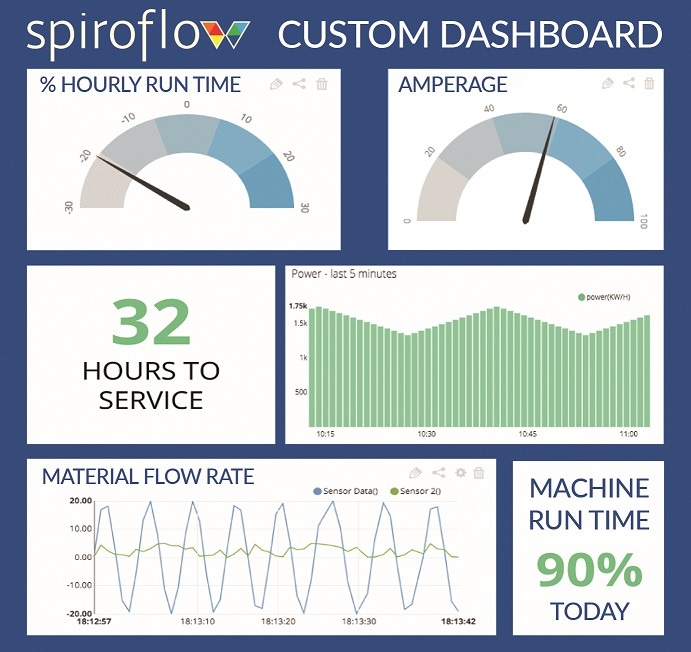Powerful Benefits of IIoT in Manufacturing
February 22, 2019

Welcome to the connected world. Virtually every home today has some form of connected device be it a smartphone, Alexa, Google Home, video doorbells, networked sprinkler systems, smart plugs and smart lighting, and yes, networked refrigerators and microwaves. We can start our cars and unlock our doors from thousands of miles away. Today we can connect, control, and gather data from these devices anywhere in the world. Welcome to the Internet of Things (IoT).
IoT is a network of sensors, intelligent systems, and computers that are connected via the Internet to share, control and collect data.
The Industrial IoT (IIoT) has the potential to be much more advanced and of greater financial benefit to manufacturers than the commercial IoT, primarily due to the prevalence of connected sensors in the industrial world. With advances in control and communication technology, virtually any machine sensor can provide data that can then be monitored, reviewed, and reported real time on PCs, tablets, smartphones, and smart watches. No longer is an operator required to constantly monitor equipment or processes or is manual data collection and analysis required as this information can be collected, processed, and exceptions reported on a real time basis.
With 66% of early movers in manufacturing saying that IIoT is now critical in creating a competitive advantage[1], its beneficial for manufacturers to develop systems that help them get better connected to their data. IIoT uses sensor-based technology to deliver key performance related, safety and operational benefits.
Extensive software packages now exist using machine learning and artificial intelligence for fault finding and analysis of the system components, as well as monitoring and documenting the safety, overall awareness of system health, visibility of equipment status and machine efficiency, can be added to IIoT technology allowing information to be pushed anywhere in the world from a multitude of devices.
Instead of immediately calling on the services of either internal staff or those of the system manufacturer, IIoT devices can first clarify the problem via the Internet, intranet, or mobile data and quickly analyze faults that can be isolated in extensive nets, with the causes being specified. This allows for quick and precise remedial measures to be implemented, meaning that reaction times are considerably reduced and costs for internal and external staff can be optimized.
Key Benefits of IIOT
Safety: users can be alerted to potential safety breaches before they arise. Receive critical information to enhance reporting on safety.
Workplace safety is essential to achieving optimal operation, avoiding substantial production interruptions, and most importantly, protecting employees. With IIoT, you get site wide visibility of your equipment allowing you to view key indicators in not only production, but also in safety compliance. This in turn allows you to be proactive in being able to spot possible safety gaps in your process.
Many processes rely on outdated methods of safety data collection some using pen and paper reporting, and some have no reporting at all. This may give rise to safety standards slipping, delays in reporting data and even senior-level management, who are ultimately responsible for mitigating those risks, receiving biased data on safety breaches.
Awareness: Reduce or eliminate unplanned downtime by moving to planned preventative maintenance.
IIoT gives you the ability to collect and analyze the data from your machines and develop a program for predictive maintenance, as well as pinpointing potential bottlenecks in your process. Previously, when a system failed it could result in costly unplanned downtime and routine inspections resulting in a change of spare parts. With IIoT technology, sensors could continually report data back to the right people and will notify them before critical failure. Reports suggest that 40% of organizations are not using any form of predictive maintenance at all[2], but that unplanned outages could be cut by up to 50% with IIoT devices[3].
With IIoT, maintenance is no longer reactive, but proactive, with both real time data as well as historical being made available. Manufacturers working towards zero unplanned downtime can benefit from intelligent insights that will improve efficiency and reduce costs.
Visibility: Gain critical visibility at multiple levels of operation utilizing a wide range of sensory inputs.
By selecting the problems you want to solve, IIoT can track and report on data you need the most. Immediate action can be taken with specific IIoT reports being sent to your PC or laptop, mobile devices and tablets, and even wearable smart devices such as watches. Often in manufacturing, if the correct action is not taken at the right time it can be detrimental to production and result in a disproportionate loss of profits over a planned maintenance. With 82% of asset failures occurring randomly[4], IIoT devices will indicate how and when the failure occurred and will learn from this event, enabling it to predict future events more accurately.
Efficiency: Reduce disruption to operations and costly workarounds by monitoring efficiency and repairing assets before they fail.
By accessing existing data and presenting it to the right people at the right time, key processes can improve with quality control, reduced downtime and energy efficiencies.
Manufacturers know that their profitability is reliant on having an accurate, high quality and reliable production output. And as, according to Verizon, 60% of early-movers are improving the reliability or performance of products and services with IIoT[5], being able to pinpoint the issues that can cause a poor-quality product is essential, especially if the problem is caused by faulty equipment.
If your equipment is not calibrated properly, not properly maintained, or not set up correctly, this can lead to issues with the product that could be avoided. IIoT will use the sensors to track and analyze the information and report back to key employees in real-time, who in-turn can stop production immediately to resolve the issues.
If a machine stops working in the middle of a shift and there are no critical spare parts on site, long delays can occur which can be expensive. It has been reported that IIoT devices could eliminate up to 70% of breakdowns[6] by reporting the data back to key individuals, who could take decisive action before critical failure. This will overall improve the efficiency of production as maintenance can be planned and scheduled to specific times.
With IIOT you will get faster and better-informed decision making by unlocking critical data about equipment performance and putting the facts into the right hands. It will pinpoint any system bottlenecking and wasting production “up time” giving you the capability to see the system, but also being modular, it will allow you to further streamline your process for lean manufacture.
Craig Hollings is development engineer, Spiroflow, a global leader in the field of powder handling and dry bulk solids processing for more than 45 years. To learn more, visit spiroflow.com/samsaves, email [email protected], or call 704-246-0900.
1 Verizon: State of the Market with IIoT https://enterprise.verizon.com/resources/reports/state-of-the-market-internet-of-things/
2 Enterprise Asset Management and Field Service Management, ARC Advisory Group, 04/17/2015. http://www.arcweb.com/market-studies/pages/enterprise-asset-management.aspx
3 Fortune http://fortune.com/2015/07/22/mckinsey-internet-of-things/
4 ARC view, Optimize Asset Performance with Industrial IoT and Analytics, August 2015 http://www-01.ibm.com/common/ssi/cgi-bin/ssialias?subtype=
WH&infotype=SA&htmlfid=WWL12350USEN&attachment=WWL12350USEN.PDF
5 Verizon: State of the Market with IIoT https://enterprise.verizon.com/resources/reports/state-of-the-market-internet-of-things/
6 G.P. Sullivan, R. Pugh, A.P. Melendez and W.D. Hunt, “Operations & Maintenance Best Practices: A Guide to Achieving Operational Efficiency, Release 3.0,” Pacific Northwest National Laboratory, U.S.
Department of Energy, August 2010.
You May Also Like


